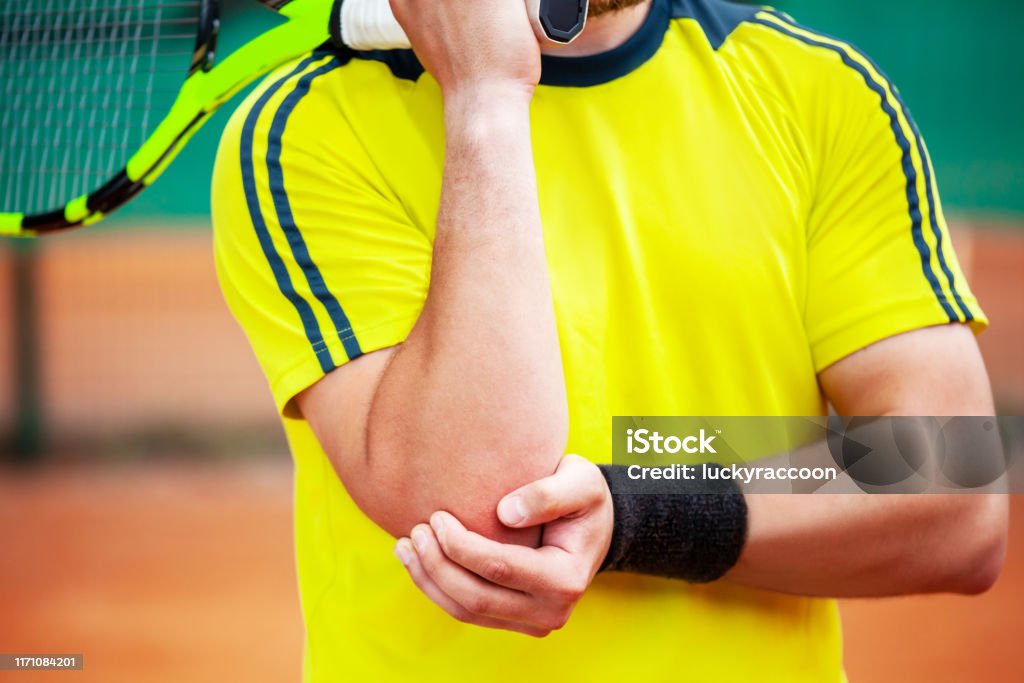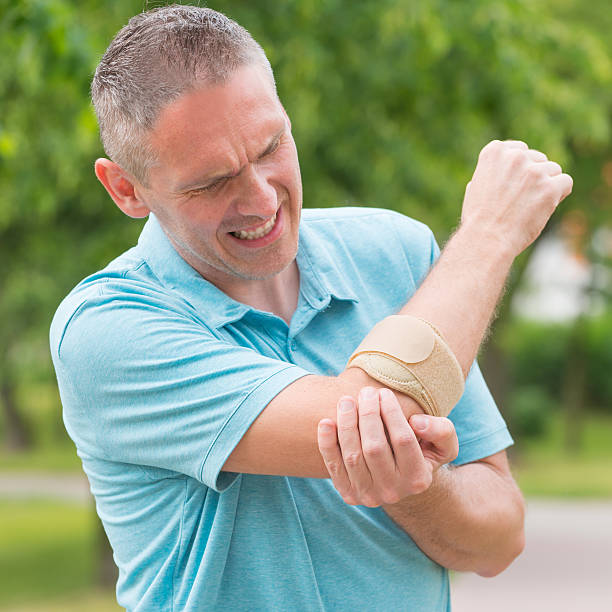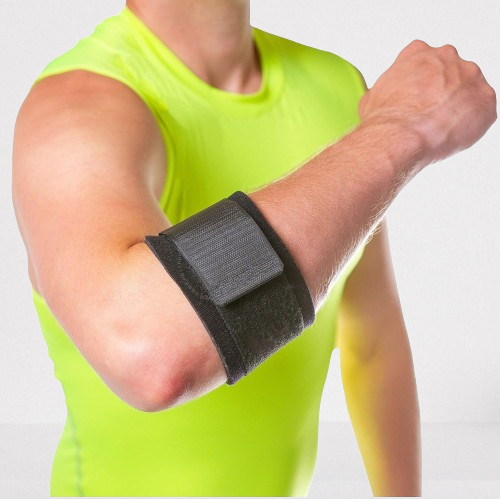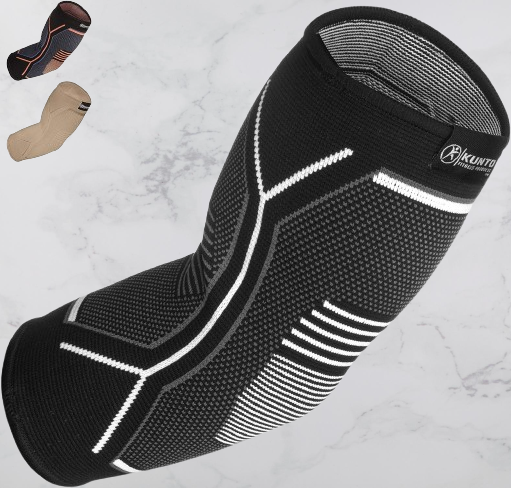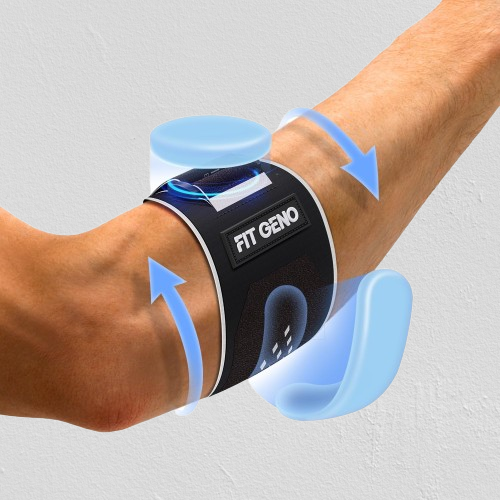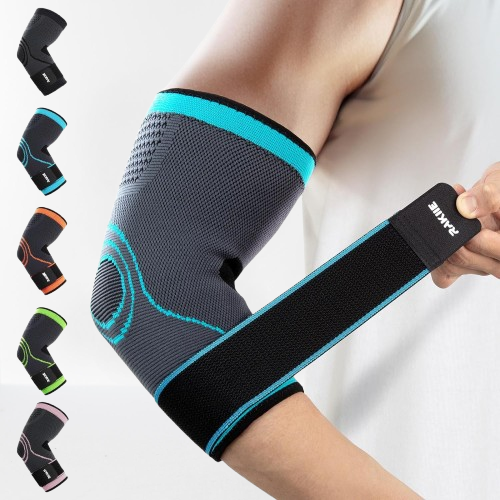Tennis elbow, clinically known as lateral epicondylitis, is a painful condition that affects thousands of athletes, laborers, and office professionals. Whether you’re a tennis player, golfer, weightlifter, or desk-bound worker, repetitive strain on the forearm tendons can lead to debilitating elbow pain. One of the most effective non-invasive solutions is the use of a tennis elbow support brace. These braces reduce strain on the tendons, offer structural support, and promote faster recovery.
In this guide, we dive deep into the best tennis elbow support braces, examining how they work, what features to prioritize, and how to choose the ideal brace for your specific condition and lifestyle.
A tennis elbow brace is a strap or sleeve worn around the forearm, just below the elbow. Its primary function is to relieve pressure on the extensor tendons and stabilize the muscles involved in wrist and hand movements. Braces either compress the muscle tissue or offer orthopedic alignment, both of which help alleviate pain and prevent further injury.
By applying targeted compression, these supports redistribute muscle force, allowing inflamed tendons to rest and heal. Some models also feature gel pads, copper-infused materials, or adjustable tension systems for personalized therapy.
It results from repetitive strain and overuse of the forearm muscles and tendons, often caused by activities beyond tennis, including weightlifting, gardening, typing, and even painting. One of the most effective, non-invasive ways to combat this painful condition is by using a high-quality tennis elbow support brace. In this comprehensive guide, we explore everything you need to know about choosing the best tennis elbow support brace for lasting relief and accelerated recovery.
Benefits of Using Best Tennis Elbow Support Brace
Tennis elbow, also known as lateral epicondylitis, is a condition characterized by pain and inflammation in the tendons that connect the forearm muscles to the outside of the elbow. This condition is typically caused by repetitive motion and overuse of the arm and forearm muscles, which can lead to small tears in the tendon. Although it is often associated with tennis players, many people from various professions and lifestyles experience tennis elbow due to everyday tasks and physical activities. One of the most effective and accessible ways to manage the symptoms and promote healing is through the use of a high-quality tennis elbow support brace.
A well-designed tennis elbow support brace can provide substantial relief by applying gentle pressure to the affected area. This pressure helps reduce strain on the tendons and muscles in the forearm, alleviating pain and minimizing further damage. The consistent compression offered by the brace reduces inflammation and allows the muscles to rest, which is crucial for recovery. This targeted support can make a significant difference in day-to-day comfort and function, allowing individuals to perform their normal activities with reduced discomfort.
The use of a tennis elbow support brace also helps to stabilize the joint and limit excessive movement that could worsen the injury. By keeping the elbow and forearm in a more controlled position, the brace prevents overextension or repetitive strain that might otherwise prolong the healing process. This stability is especially beneficial for those who cannot completely rest their arm due to work or daily responsibilities. Wearing the brace can act as a safeguard, allowing individuals to stay active while protecting the injured area from further stress.
Another benefit of using a tennis elbow support brace is the way it encourages proper blood circulation. Enhanced circulation is essential for tissue repair, as it ensures that oxygen and nutrients are delivered efficiently to the site of injury. The gentle compression from the brace stimulates blood flow without restricting movement, which helps to accelerate healing and reduce muscle fatigue. As the condition improves, the brace can be used as part of a gradual return to normal activity, providing support throughout the rehabilitation process.
In addition to its physical benefits, wearing a tennis elbow brace can offer psychological comfort and confidence. Knowing that the affected arm is supported can give individuals the peace of mind needed to continue with daily activities without the constant fear of worsening the injury. This sense of security encourages gradual and healthy movement, which is important for avoiding stiffness and regaining strength in the arm. Confidence plays a key role in recovery, especially when returning to activities that originally contributed to the condition.
Comfort and convenience are also significant advantages of the best tennis elbow support braces. Modern designs are made with soft, breathable materials that provide a snug fit without causing skin irritation. Many are lightweight and unobtrusive, allowing them to be worn under clothing or during sleep. Adjustable straps make it easy to customize the level of compression for each individual’s needs, ensuring optimal support and comfort throughout the day. Because of these user-friendly features, braces can be worn consistently, which is essential for long-term healing and prevention.
Financially, using a tennis elbow support brace is a cost-effective solution compared to other treatment options. While physical therapy, medications, and even surgery can be expensive and time-consuming, a brace provides an affordable and immediate way to address symptoms. It can also be used in conjunction with other treatments as part of a comprehensive recovery plan. For those seeking a practical, low-risk way to manage their condition, investing in a high-quality support brace is often a smart and accessible choice.
Furthermore, the brace serves not only as a treatment tool but also as a preventative measure. Individuals who engage in repetitive arm motions or heavy lifting can wear the brace as a form of protection against potential injury. By supporting the tendons and muscles during high-risk activities, the brace helps reduce the chances of developing tennis elbow in the first place. This proactive use can be especially valuable for athletes, manual laborers, and anyone involved in regular physical activity.
In summary, using the best tennis elbow support brace offers a comprehensive range of benefits that go beyond pain relief. From stabilizing the joint and promoting healing to improving comfort, confidence, and even preventing future injuries, a brace is a versatile and essential tool in managing lateral epicondylitis. Its affordability, convenience, and effectiveness make it a reliable option for anyone experiencing or at risk of tennis elbow, helping them return to a pain-free and active lifestyle.
Importance of Using Best Tennis Elbow Support Brace
Tennis elbow, medically known as lateral epicondylitis, is a condition that results from the overuse of the muscles and tendons in the forearm, particularly the ones attached to the outer elbow. While tennis players are often associated with this injury, it can affect anyone who performs repetitive arm and wrist motions. Activities such as gardening, painting, and even prolonged computer use can put significant strain on the forearm muscles, leading to pain and discomfort in the elbow. The pain typically manifests on the outside of the elbow, and in severe cases, it can even radiate down the forearm. One of the most effective ways to manage and alleviate the symptoms of tennis elbow is by using the best tennis elbow support brace.
A tennis elbow brace is designed to provide support to the injured area, helping to reduce strain on the muscles and tendons while promoting healing. The importance of using a high-quality brace cannot be overstated. It not only assists in alleviating the pain but also helps in preventing further injury. A well-designed brace works by compressing the affected area, stabilizing the elbow joint, and redistributing the force that is exerted on the tendons during movement. This can significantly reduce the intensity of pain, allowing individuals to engage in daily activities or sports with less discomfort.
One of the key reasons why a tennis elbow support brace is so essential is its ability to provide immediate relief from pain. The compression provided by the brace helps to reduce swelling and inflammation around the elbow. By stabilizing the elbow joint and the surrounding muscles, the brace minimizes the likelihood of excessive movement that might otherwise exacerbate the injury. This is especially important for individuals who need to continue using their arms during work or other activities. Without proper support, the strain placed on the muscles can worsen the condition, making it more difficult to recover over time.
In addition to pain relief, using the best tennis elbow support brace helps in promoting long-term recovery. Tennis elbow injuries can take weeks or even months to heal completely. During this recovery period, the body needs time to repair the damaged tendons and muscles. A good-quality brace aids in this process by reducing the risk of further strain or injury. By wearing a brace, individuals can gradually resume their normal activities without overburdening the injured area, ensuring that the healing process is not interrupted or slowed down. This can be particularly beneficial for athletes or individuals whose professions require frequent use of their arms.
The benefits of a tennis elbow support brace extend beyond just physical relief. For many people, the psychological impact of dealing with chronic pain can be overwhelming. The constant discomfort can lead to frustration and a reduced quality of life. By wearing a high-quality support brace, individuals can feel more confident in their ability to manage the condition and regain control over their daily activities. Knowing that they have the necessary support can help reduce the anxiety and stress associated with the injury, making the recovery process less daunting.
Furthermore, the best tennis elbow support braces are designed to be comfortable and non-intrusive. Many of the newer models are lightweight, breathable, and adjustable, ensuring a snug fit without restricting movement. This allows individuals to wear the brace for extended periods without discomfort, making it easier to incorporate into daily life. Whether you’re working, exercising, or simply going about your day-to-day tasks, a good brace should not interfere with your movements. Instead, it should enhance your ability to perform activities while providing the necessary support to avoid exacerbating the injury.
Wearing the best tennis elbow support brace also offers an added layer of protection during physical activities or sports. Even if the injury is healing, the elbow may still be vulnerable to re-injury, especially if a person returns to their sport too soon. The brace helps to protect the elbow from sudden movements that could potentially aggravate the condition. This is particularly important for athletes who rely on their arms for performance. A well-fitted brace can allow them to play their sport without compromising their recovery or causing additional harm to the elbow.
Finally, the best tennis elbow support brace can be an essential tool in preventing future injuries. Even after the injury has healed, the forearm muscles and tendons may still be weak, and they could be susceptible to re-injury if subjected to the same repetitive stress. Wearing a brace during activities that involve repetitive arm motions can provide the added support needed to prevent strain on the elbow, reducing the risk of a recurrence. In this way, the brace serves as a preventive measure, safeguarding against future injuries and helping individuals maintain a healthy, active lifestyle.
In conclusion, using the best tennis elbow support brace is crucial for anyone dealing with the discomfort and pain of tennis elbow. It offers immediate pain relief, promotes healing, protects against further injury, and provides peace of mind during recovery. Whether you’re an athlete, a professional, or simply someone suffering from the condition, investing in a high-quality tennis elbow brace can significantly improve your ability to manage the injury and return to your normal activities. With the right support, recovery can be faster, more comfortable, and ultimately more successful.
Types of Best Tennis Elbow Support Brace
Tennis elbow, or lateral epicondylitis, is a common condition that causes pain and inflammation on the outer part of the elbow. It is often caused by repetitive motions, such as those made while playing tennis, but it can also occur in individuals who engage in activities that involve gripping, twisting, or lifting. One of the most effective ways to manage the symptoms of tennis elbow is by using a support brace. These braces are designed to alleviate pain, reduce strain, and promote healing. There are various types of tennis elbow support braces available, each catering to different needs and preferences. Understanding these different types can help individuals select the best brace for their specific condition.
The most common type of tennis elbow support brace is the counterforce brace. This brace is designed to apply pressure to the forearm muscles, which helps reduce the strain on the tendons of the elbow. Counterforce braces are typically worn around the upper forearm, just below the elbow, and they feature a strap or pad that compresses the muscles to minimize the force exerted on the tendons during movement. This type of brace is ideal for individuals who experience pain while gripping or lifting, as it provides support without restricting elbow movement. Counterforce braces are often recommended for people who are actively engaging in physical activities but need additional support for their elbow.
Another popular option is the elbow sleeve. Unlike the counterforce brace, which focuses on providing direct pressure to the forearm, an elbow sleeve is a more lightweight and flexible option. Elbow sleeves are typically made from elastic or compression materials that fit snugly around the elbow joint, providing gentle compression to the affected area. This type of brace can help reduce swelling and inflammation while also providing a sense of warmth to the elbow. Elbow sleeves are a good choice for individuals who need continuous, mild support throughout the day, especially if they are performing activities that involve repetitive elbow motions. They are also a great option for those who do not want to wear a bulky brace but still require some level of relief from the discomfort of tennis elbow.
For those seeking a more customized fit, adjustable braces are a viable option. These braces feature adjustable straps or Velcro fastenings, allowing users to modify the level of compression based on their comfort level. The ability to adjust the tightness of the brace ensures that it can accommodate different arm sizes and provide optimal support without being too restrictive. Adjustable braces are also versatile, as they can be worn during a variety of activities. These braces offer a balance between support and flexibility, making them suitable for both active individuals and those who need support during rest periods.
For individuals experiencing severe pain or discomfort, a stabilizing brace might be the best option. Stabilizing braces are typically more rigid than other types of tennis elbow braces and are designed to limit the movement of the elbow joint. These braces often feature splints or rigid panels that prevent excessive bending or twisting of the elbow. By restricting movement, stabilizing braces help protect the injured tendons and prevent further strain, allowing for more effective healing. This type of brace is often recommended for those who need to completely immobilize the elbow for a period of time, especially in the early stages of recovery.
In some cases, a forearm band or strap may be sufficient to provide relief from tennis elbow. These bands are worn around the forearm, just below the elbow, and are designed to apply pressure to the muscles of the forearm. This pressure helps reduce the load on the elbow joint and alleviates pain. Forearm bands are often used as a supplementary tool to aid in the management of tennis elbow symptoms, especially when combined with other forms of treatment such as physical therapy or rest. They are lightweight and discreet, making them easy to wear throughout the day without interfering with daily activities.
When selecting a tennis elbow support brace, it is important to consider the level of support required and the type of activity in which the individual is involved. For active individuals who need support during sports or exercise, a counterforce brace or forearm band may be the most effective. Those who need constant support throughout the day or during light activities may benefit from an elbow sleeve or adjustable brace. For more severe cases, a stabilizing brace can provide the necessary immobilization and protection. It is also important to consider the material and design of the brace, as comfort and breathability are essential for long-term wear.
In conclusion, tennis elbow support braces come in a variety of types, each offering different levels of support and comfort. Whether you are an athlete seeking relief during sports, an office worker managing symptoms throughout the day, or someone recovering from a more severe injury, there is a brace designed to meet your specific needs. By understanding the different types of braces available and how they work, individuals can make an informed decision that helps manage their tennis elbow pain and promotes a quicker recovery.
Features of the Best Tennis Elbow Support Brace
Tennis elbow, also known as lateral epicondylitis, is a common condition that causes pain and discomfort around the outside of the elbow due to overuse of the forearm muscles. This condition can affect anyone, not just tennis players, and can be debilitating if not managed correctly. One of the most effective ways to manage tennis elbow symptoms is by using a support brace. A well-designed tennis elbow brace provides targeted compression and support to the affected area, helping to reduce pain, promote healing, and prevent further injury. However, not all braces are created equal, and choosing the right one can make all the difference.
The best tennis elbow support brace should have several key features that make it effective and comfortable. One of the most important aspects is its ability to provide firm yet adjustable compression. Compression plays a crucial role in alleviating pain by reducing swelling and improving blood circulation to the injured area. A high-quality brace will allow you to adjust the level of compression to your comfort, which ensures that it can accommodate varying degrees of swelling or discomfort throughout the day. This flexibility is particularly important because tennis elbow symptoms can fluctuate, so the ability to adjust the brace is essential for continued relief.
Equally important is the brace’s ability to stabilize the elbow joint. A good tennis elbow support should provide adequate stabilization to prevent further strain on the tendons and muscles that are causing the pain. This is especially useful when engaging in physical activities, such as sports or manual labor, where the elbow joint is subject to repeated stress. The support should be designed in such a way that it limits unnecessary movement of the elbow while still allowing for natural motion during everyday activities. Some braces come with straps or additional padding that help to further enhance stability, making it easier to use the arm without aggravating the injury.
Material quality is another critical factor when choosing a tennis elbow brace. The best braces are made from breathable, lightweight, and moisture-wicking materials. These fabrics help keep the skin dry and comfortable, reducing the risk of irritation or chafing during extended wear. Materials like neoprene or nylon are often used in the construction of high-quality tennis elbow braces because they offer the perfect balance between durability, comfort, and flexibility. Additionally, some braces come with a soft inner lining that adds extra comfort, making them more pleasant to wear for long periods. This is especially important for individuals who need to wear the brace throughout the day while working or participating in sports activities.
Another key feature to look for is the brace’s design. The best tennis elbow braces are ergonomically designed to conform to the natural shape of the elbow and forearm. This ensures that the brace does not restrict movement or cause discomfort, even with prolonged use. Some braces feature a contoured design that fits snugly around the elbow, providing precise support where it is needed most. Others are equipped with adjustable straps or hook-and-loop closures, which allow for a more customized fit. A brace with a snug, tailored fit is less likely to slip or shift during physical activities, ensuring consistent support.
Ease of use is another consideration when selecting a tennis elbow brace. A good brace should be easy to put on and take off, even for individuals with limited mobility or strength. Many braces are designed with user-friendly features like quick-fastening straps or Velcro closures, making it simple to adjust the fit without the need for assistance. This is particularly beneficial for people who may be wearing the brace multiple times a day and want to avoid the hassle of complicated fastening systems.
One of the most beneficial features of a high-quality tennis elbow brace is its versatility. The best braces can be worn during a variety of activities, including exercise, work, and leisure. Whether you are playing tennis, lifting weights, typing at a desk, or engaging in other daily tasks, a good brace will offer the support you need without hindering your range of motion. Furthermore, many braces are discreet enough to wear under clothing, which is important for individuals who want to continue with their routine without drawing attention to their injury.
In addition to the practical aspects, the best tennis elbow braces also focus on long-term healing. While they help to alleviate pain in the short term, they are also designed to promote healing by reducing strain on the affected tendons and muscles. Some braces are equipped with additional therapeutic features, such as pressure pads or gel inserts, which provide extra support to specific areas of the elbow, further enhancing the healing process.
When choosing the best tennis elbow support brace, it’s essential to consider factors such as comfort, fit, and functionality. A good brace should provide the necessary support and compression to relieve pain and promote recovery while allowing for a full range of motion. It should be made from high-quality, breathable materials that ensure comfort during prolonged wear. Finally, the brace should be easy to use and versatile enough to accommodate various activities, ensuring that you can continue your daily routine without further exacerbating the condition. By choosing a brace that meets these criteria, you can effectively manage tennis elbow symptoms and aid in your recovery process.
How to Wear and Use Best Tennis Elbow Support Brace Properly?
When dealing with tennis elbow, medically known as lateral epicondylitis, finding the right treatment and support for the condition is essential. One of the most common remedies recommended by healthcare professionals is using a tennis elbow support brace. This simple yet effective device helps reduce pain, alleviate pressure on the affected tendons, and promote healing. However, to fully benefit from a tennis elbow brace, it is crucial to understand how to wear and use it properly. In this guide, we’ll explore how to correctly use the best tennis elbow support brace, ensuring optimal relief and healing.
Tennis elbow occurs when the tendons that attach to the outside of the elbow become inflamed due to repetitive use or overloading of the muscles and tendons. Symptoms of tennis elbow include pain and tenderness on the outer part of the elbow, often radiating down to the forearm. While rest and physical therapy are important in treating the condition, using a tennis elbow support brace can provide added relief and help with the healing process.
Choosing the right tennis elbow brace is the first step in ensuring its effectiveness. There are several types of braces available, such as compression sleeves, strap-based supports, and those with gel inserts. Each type works differently, so selecting one that suits your specific needs is important. A compression sleeve provides even pressure around the elbow and forearm, which helps reduce swelling and pain. A strap-style brace, on the other hand, targets the muscles and tendons around the elbow joint, applying pressure directly where it’s most needed. Gel braces are often designed for added comfort, as they include cushioning that protects the elbow from further irritation.
Once you’ve chosen a brace, it’s time to learn how to wear it properly. To get the maximum benefit, the brace should be worn snugly, but not too tight. It should fit comfortably around your elbow, providing support without cutting off circulation. Many braces are designed to fit either the left or right elbow, so make sure to choose the correct one for your affected arm. Before wearing the brace, make sure that your skin is clean and dry, as moisture can cause irritation and discomfort when the brace is worn for long periods. It’s also a good idea to check that there are no loose seams or edges that might cause chafing while wearing it.
When applying the brace, it should be positioned so that it rests comfortably just below the elbow joint, typically around the forearm. For a strap-based brace, the strap should be placed a few inches below the elbow joint on the forearm. This placement helps to relieve pressure on the tendons in the elbow and redirect the strain to the forearm muscles. For compression sleeves, ensure that the sleeve fits tightly and covers both the upper part of the forearm and the lower part of the upper arm. The goal is to create even pressure to reduce inflammation and promote blood flow to the affected area.
It is essential to wear the tennis elbow brace at the right times to achieve maximum relief. In most cases, wearing the brace during activities that aggravate the condition, such as lifting, repetitive arm movements, or playing sports, will help minimize pain. For people with tennis elbow, these activities can exacerbate the inflammation, making it difficult for the tendons to heal. Wearing the brace during these moments can provide support and prevent further strain on the elbow joint. However, it is equally important to remove the brace when not engaging in physical activity. Continuous use of the brace may cause skin irritation or interfere with the muscle’s natural ability to move. When at rest, it’s a good idea to allow the elbow to breathe and heal naturally.
Additionally, the length of time you wear the brace is a crucial factor in maximizing its effectiveness. While there is no set rule, many users find that wearing it during work or exercise for several hours a day provides adequate support. However, wearing it too long without removing it can lead to discomfort or decreased effectiveness. The ideal approach is to wear the brace for as long as it is beneficial for pain relief, but take breaks when possible to give your skin and muscles some rest.
In addition to wearing the brace, incorporating physical therapy into your treatment plan can help strengthen the muscles around the elbow and reduce the risk of further injury. Tennis elbow braces are not a cure, but they play a significant role in the healing process by providing support during activities that strain the elbow. Exercises designed to stretch and strengthen the forearm muscles can complement the brace’s support and accelerate recovery. Consulting with a physical therapist can ensure you are following the right exercises and stretches to avoid re-injury.
Lastly, make sure to monitor your progress. If you find that the brace isn’t providing adequate support or comfort, or if the pain persists, it might be time to reassess your choice of brace or consult with a healthcare provider. Sometimes, a different type of brace or additional treatment options may be necessary.
In conclusion, wearing and using a tennis elbow support brace properly can significantly aid in the recovery process by providing the right amount of support and reducing strain on the elbow tendons. Choosing the right type of brace, ensuring proper fit, and using it during the right times are key to maximizing its benefits. However, remember that the brace should be used in conjunction with other treatments like physical therapy and rest for the best results. With patience and proper care, most individuals experience relief from tennis elbow symptoms and return to their daily activities without pain.
How to care for an Best Tennis Elbow Support Brace?
When it comes to managing tennis elbow, one of the most effective methods of support is using a tennis elbow support brace. Tennis elbow, or lateral epicondylitis, is a painful condition that affects the outer part of the elbow, often caused by repetitive motions or overuse of the forearm muscles. A tennis elbow brace helps alleviate pain, reduce strain, and speed up recovery. However, to ensure that the brace works effectively and lasts a long time, proper care is essential. Understanding how to care for your best tennis elbow support brace can make a significant difference in its effectiveness and longevity.
First and foremost, it is crucial to choose the right brace for your needs. Tennis elbow braces come in different types, such as compression sleeves, straps, and full elbow braces. Each design serves a different purpose, so selecting the correct one is the first step in ensuring comfort and effectiveness. A brace that fits well, provides proper compression, and targets the affected area will offer maximum support. Before you begin using the brace, make sure it is the right size. A brace that is too tight may cause discomfort and restrict blood flow, while one that is too loose may not provide the necessary support.
Once you’ve chosen the right brace, it’s important to wear it correctly. Follow the manufacturer’s instructions regarding how to wear the brace. Most braces are designed to be worn during physical activities or while at rest, but it’s essential to follow the recommended duration. Overuse of the brace can lead to skin irritation or even additional strain on the muscles. Additionally, it’s essential to ensure that the brace is positioned in the right area, typically around the forearm just below the elbow joint, to provide optimal support and reduce the strain on the tendons.
Another critical aspect of caring for your tennis elbow brace is ensuring that it remains clean. Like any piece of athletic gear, braces can accumulate sweat, dirt, and bacteria from frequent use. Regularly cleaning the brace will help maintain its effectiveness and ensure it does not cause any irritation or infections. Many braces are machine washable, but it is important to check the label to confirm the care instructions. For hand-washable braces, use a mild detergent and lukewarm water to gently clean the brace. Avoid using harsh chemicals or bleach, as these can damage the fabric and affect the brace’s ability to provide support. After washing, allow the brace to air dry. Do not use a dryer, as the heat may cause the fabric to shrink or lose its elasticity.
Storing the brace properly is another key consideration. When you are not using your tennis elbow support, store it in a cool, dry place, away from direct sunlight and heat. Avoid folding the brace too tightly, as this can affect its shape and compromise the effectiveness of the compression. If your brace is made of neoprene or similar materials, storing it in a dry, well-ventilated area will prevent the material from becoming too stiff or losing its stretch.
In addition to proper cleaning and storage, it’s important to regularly inspect the brace for any signs of wear and tear. Over time, the fabric may begin to stretch out or lose its elasticity, especially if the brace is frequently exposed to moisture or rough usage. Check for any frayed edges, loose straps, or other damage that may affect the brace’s fit and functionality. If you notice any damage, it might be time to replace the brace to ensure continued support. It is advisable to replace the brace when it no longer provides the necessary compression or support.
When using a tennis elbow brace, it’s important not to rely solely on the brace for healing. While it can help alleviate pain and provide support, the brace should be used in conjunction with other treatment methods such as rest, physical therapy, and exercises designed to strengthen the forearm muscles and tendons. A tennis elbow brace is a supportive tool, not a cure, and using it along with other treatments can help you recover more effectively.
Furthermore, it’s essential to remember that a brace is not a one-size-fits-all solution. If you continue to experience pain or discomfort despite using the brace correctly, or if the pain worsens, consult a healthcare professional. In some cases, the condition may require additional medical interventions such as corticosteroid injections or even surgery if conservative methods do not provide relief.
Lastly, avoid using the brace as a long-term solution without addressing the root causes of the tennis elbow. Many people with tennis elbow find that, after a period of rest and rehabilitation, they no longer need to rely on the brace. Engaging in regular strength training, improving your posture, and modifying any repetitive activities that caused the condition in the first place can help prevent future occurrences of tennis elbow.
In conclusion, taking proper care of your best tennis elbow support brace involves selecting the right brace, wearing it correctly, cleaning it regularly, storing it properly, and inspecting it for damage. While the brace can provide valuable support in managing tennis elbow, it should be used as part of a broader treatment plan that includes rest, physical therapy, and strengthening exercises. By following these guidelines, you can ensure that your tennis elbow brace continues to provide effective relief and helps you recover as quickly as possible.
